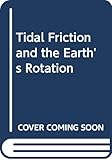Tidal friction and the earth's rotation [Libro electrónico] / editores: Peter Brosche, Jürgen Sündermann
Brosche, Peter [editor] | Sündermann, Jürgen [editor/a].
Tipo de material: Libro
en línea Editor: New York, New York, United States: Springer-Verlag, c1978Descripción: viii, 241 páginas : ilustraciones ; 24 centímetros.ISBN: 0387090460; 9783540090465 (Print); 9783642670978 (Online).Tema(s): TidesDescriptor(es) geográficos: Earth (Planet) -- RotationNota de acceso: Disponible para usuarios de ECOSUR con su clave de acceso Nota de bibliografía: Incluye bibliografía Número de sistema: 56044Contenidos:Mostrar
Resumen:
Libro
en línea Editor: New York, New York, United States: Springer-Verlag, c1978Descripción: viii, 241 páginas : ilustraciones ; 24 centímetros.ISBN: 0387090460; 9783540090465 (Print); 9783642670978 (Online).Tema(s): TidesDescriptor(es) geográficos: Earth (Planet) -- RotationNota de acceso: Disponible para usuarios de ECOSUR con su clave de acceso Nota de bibliografía: Incluye bibliografía Número de sistema: 56044Contenidos:Mostrar
Resumen:| Tipo de ítem | Biblioteca actual | Colección | Signatura | Estado | Fecha de vencimiento | Código de barras |
|---|---|---|---|---|---|---|
| Libros | Biblioteca Electrónica Recursos en línea (RE) | Acervo General | Recurso digital | ECO400560449013 |
Incluye bibliografía
1. Historical background and introduction.. 2. Pre-telescopic astronomical observations.. 3. Tidal deceleration of the earth's rotation deduced from astronomical observations in the period A D. 1600 to the present.. 4. Determination of the rotation of the earth (at present.. 5. Effect of tidal friction on the lunar orbit and the rotation of earth and its determination by laser ranging.. 6. Tides of the solid earth from gravimetric measurements.. 7. Tidal friction in the solid earth: loading tides versus body tides.. 8. Tidal dissipation in the oceans.. 9. The influence of solid earth deformations on semidiurnal and diurnal oceanic tides.. 10. Numerical computation of tidal friction for present and ancient oceans.. 11. The earth's palaeorotation.. 12. Periodic growth features in fossil organisms and the length of the day and month.. 13. Geological and geophysical evidence relating to continental growth and dynamics and the hydrosphere in precambrian times: a review and analysis.. Bibliography
Disponible para usuarios de ECOSUR con su clave de acceso
P. Brosche The development of the ideas and observational techniques related to the subject of our meeting "Tidal friction and the Earth's rotation", Bielefeld, September 1977 is one of the most fascinating books - not merely chapters! - of the modern history of science. Its genealogical tree is as intricate as that of mankind itself: There are dead ends and superfluous re-discoveries. Due to these circumstances and to the pure extent of the topic, it is impossible to give more than a few highlights here. The first relevant observational fact was discovered by the famous English astronomer E. Halley in 1695 (Berry, 1961). He simply could not arrive at an agreement between ancient and recent eclipses using a constant mean angular motion of the Moon. Instead, he had to intro duce an empirical acceleration term in the mean motion. Known as the "secular acceleration", it has ever since been a most challenging sub ject of celestial mechanics and a main branch of the genealogical tree already mentioned. In 1754, completely independently and almost certainly in ignorance of those specialists' activities, the German philosopher Kant established the idea of tidal friction as a decelerating mechanism for the rotation of the Earth (Felber, 1974). Although he made some errors in his rough computations, the majority of the constitutive elements of his concept have survived to the present day (Brosche, 1977). eng
Disponible en línea
Disponible en formato PDF
Subscripción a ELSEVIER 26 de diciembre del 2013
